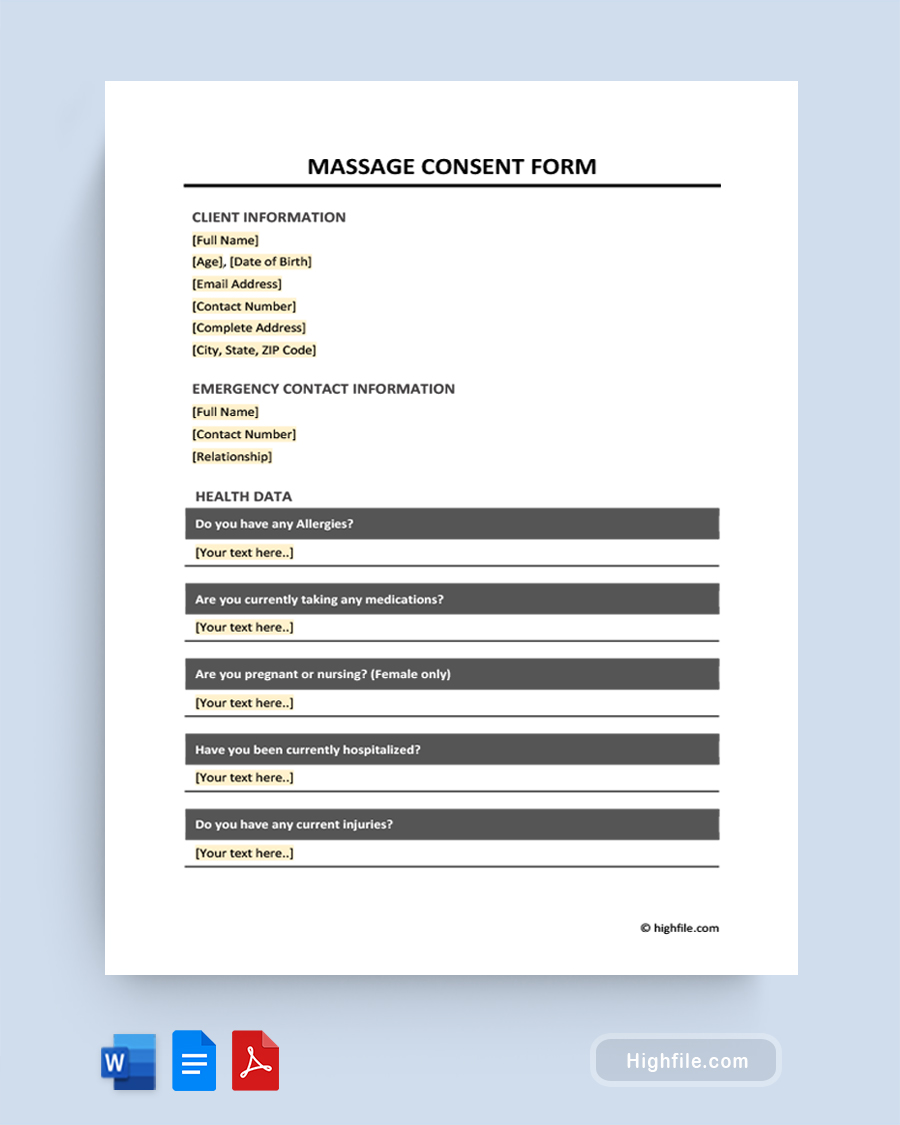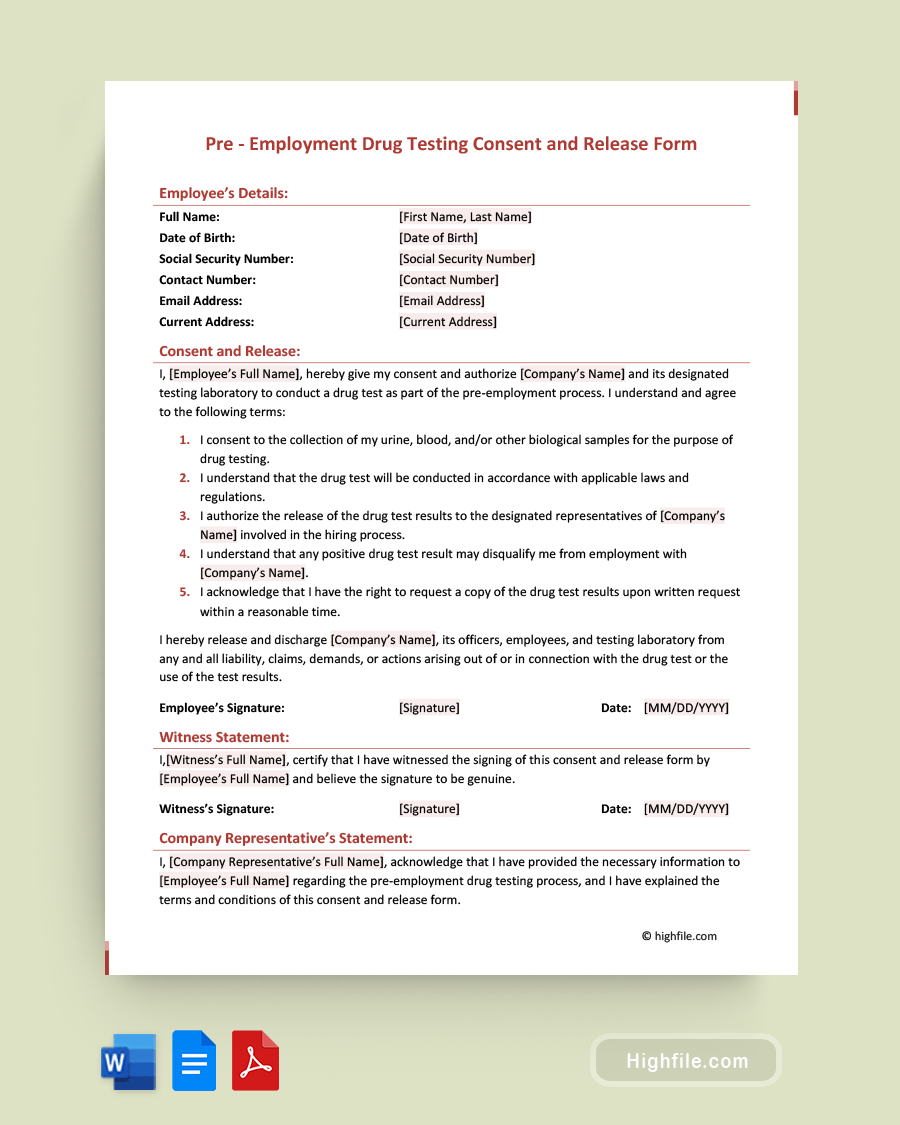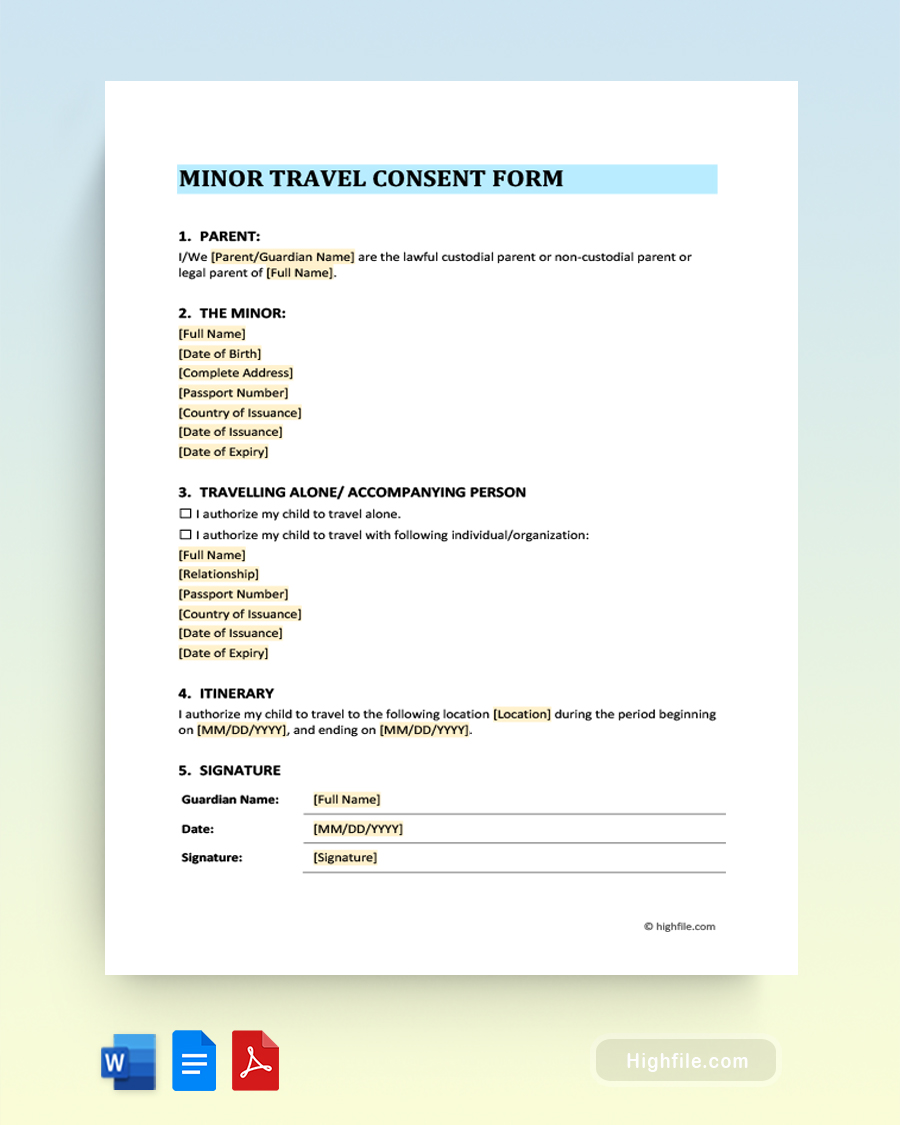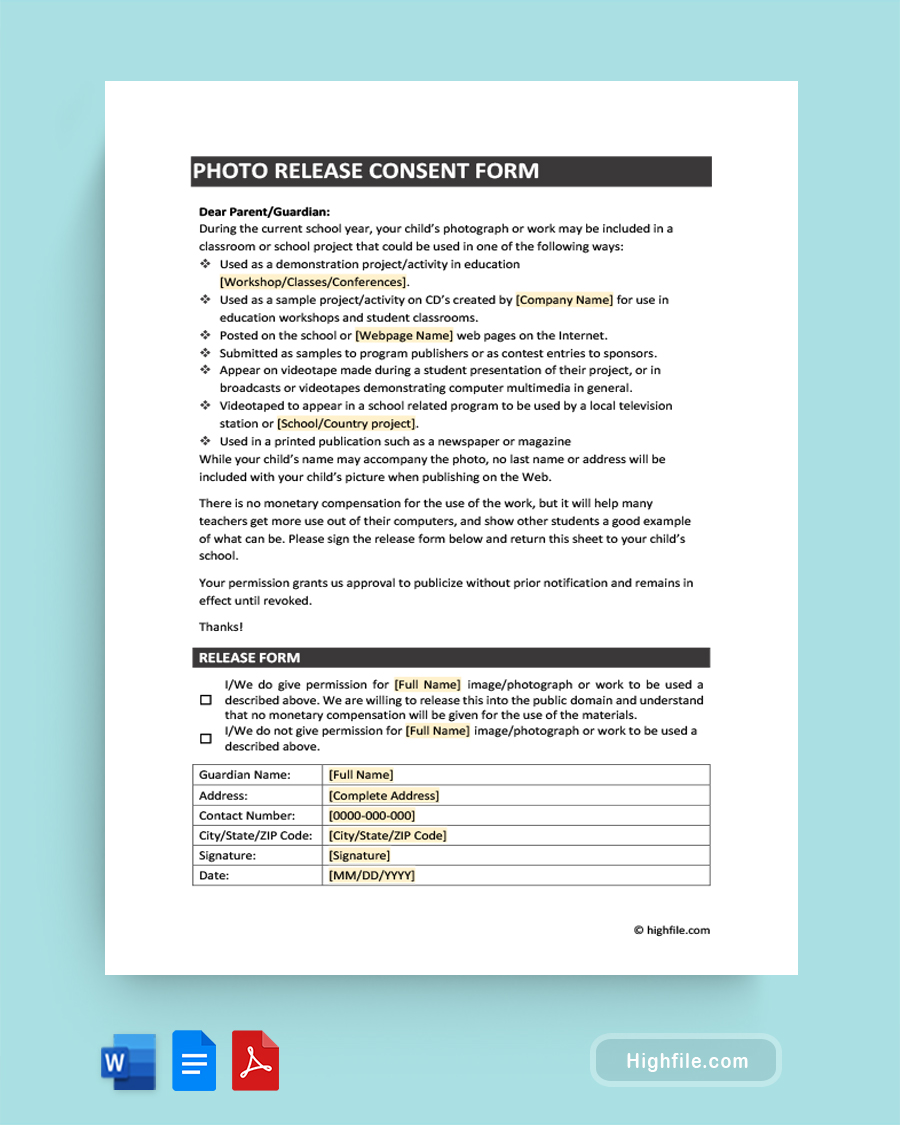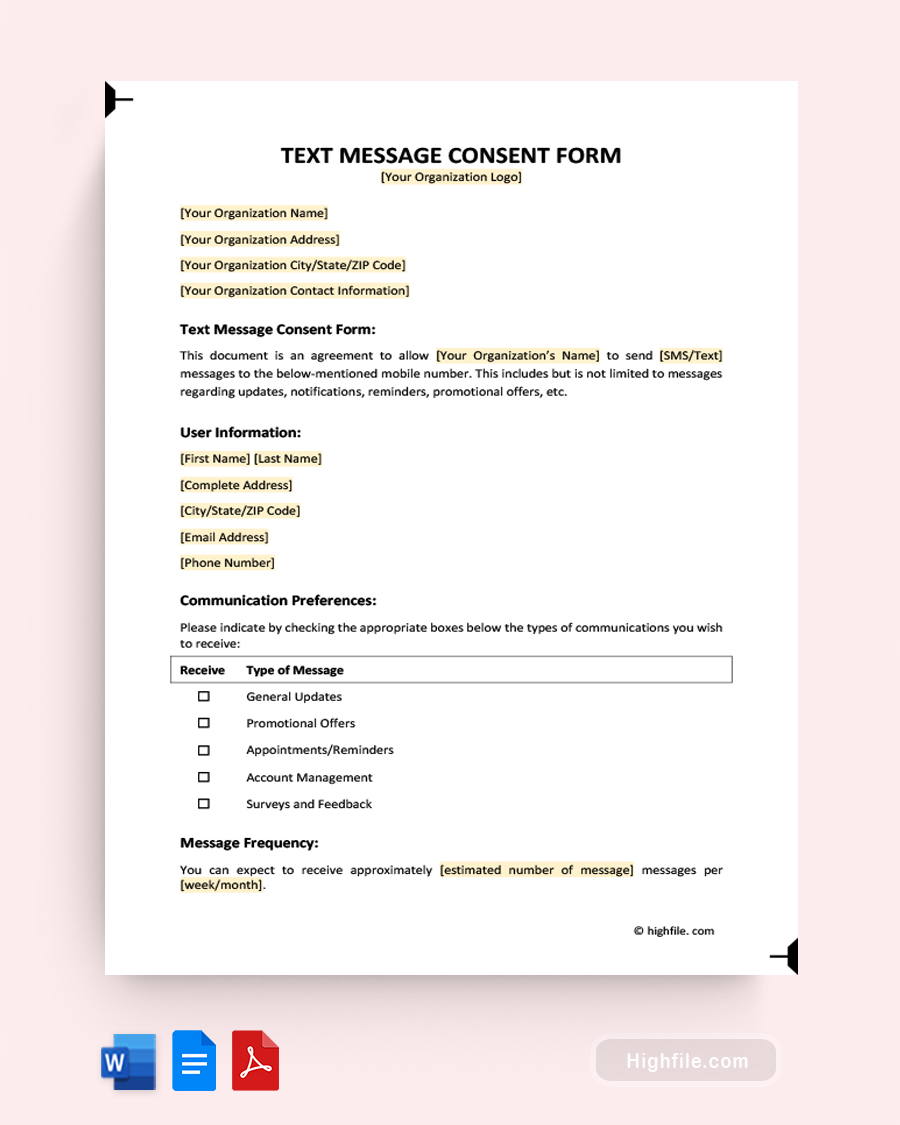Getting a massage can help with everything from minor aches and pains to increased blood flow, aiding in recovery after the client has been injured. However, before you ever place your hands on someone, you should always do an intake evaluation and have them fill out a massage consent form. These vital documents contain information about the client’s health and show that they received the treatment only after they agreed to the process. We recommend using our preformatted, professionally created massage consent form template to quickly and easily create a reusable form that ensures all your clients provide and receive the correct information and sign their consent.
What Is a Massage Consent Form?
A massage consent form, sometimes called a liability waiver, is a vital document representing a legal agreement between the client and the massage therapist. These simple forms contain the client’s information, such as their name, address, relevant health history and concerns, and typically an emergency contact. Additionally, the client provides their consent to treatment, often represented as a series of statements with checkboxes or space for initialing beside them and a signature line at the bottom. These forms provide critical information for the person performing the service and are part of the standard documentation process for spas, massage centers, clinics, and private masseurs.
Why is a Massage Consent Form Important?
There are two main reasons why a massage consent form is important. First, the document contains health and emergency contact information for the client. It is critical for a massage therapist to know whether the client has had recent surgeries, or injuries, if they are pregnant, diabetic, or have other health concerns that affect the treatment. The emergency contact is there in case of unforeseen complications, such as a client failing to disclose certain conditions that make a massage dangerous, damaging, or painful.
Secondly, the consent form shows that the business and massage therapist have done their part to obtain informed consent. When the client signs the document, it should contain acknowledgments that they’ve provided complete and correct information, read everything, and had a chance to ask any relevant questions. Since bodily autonomy is a right, a simple massage consent form can prove that the massage therapist apprised them of the process and had permission to touch them. This prevents false claims and provides legal protections for the business and massage therapist.
Pro Tip: In some rare cases, a massage can also release so much stress and tension that the recipient experiences a surge of concurrent emotional release, and they may need someone to drive them home. Though it doesn’t happen often, this is another way that massage can provide clients with relief.
Is a Massage Consent Form Legally Required
A massage consent form is only legally required in some states. However, it is always a wise, professional decision since it can save you from false litigation. Additionally, this form is often filled out with client intake forms, which are required. According to HIPAA, all licensed massage therapists must obtain a release form before taking notes about their physical health. This data is a part of the client’s medical record, and they have the right to medical confidentiality. Resultantly, the medical consent and consent to receive the massage are often bundled together or even presented on the same form for easy access.
Three Common Types of Consent in Massage Therapy
The three types of consent in massage therapy are written, verbal, and implied. The written form is your liability waiver or massage consent form. Verbal consent is part of the massage process. Massage therapists should converse with their clients as they work, keeping them informed of the process and asking if it is alright to move on to the next step, especially when massaging sensitive areas. This communication helps the person performing the massage foster trust with the client and stay informed during the process to avoid causing unnecessary pain and discomfort.
Lastly, implied consent is a little trickier. For example, when someone goes into a room with a table and towel and they strip, covering themselves with the towel, this is implied consent. They consent to remove their clothing voluntarily for the process. Any permission given by indication rather than verbally or in writing is implied consent.
Essential Elements of a Massage Consent Form
The essential elements of a massage consent form are predominantly the patient contact information, health concerns, acknowledgments, and, most importantly, a signature line. Below we’ve outlined each part and where it appears on the page.
- (Optional but Strongly Recommended) Logo or Business Name – Using your business name or a professional logo at the top is a simple customization that gives a form a professional yet unique appearance.
- Title – This should say precisely what it is, “Massage Consent Form or Massage Client Intake and Consent Form.” This part should always be in large, bold print and shows what the form is intended for at a glance.
- Name – The Client’s Full Legal Name can be typed or handwritten depending on whether the client made the appointment in advance.
- Client Contact Information – Ensure you record the client’s birthdate and contact information, including email, phone number, and street address.
- Client Emergency Contact – The name of someone local the client trusts and who can be called in case of emergencies or adverse reactions. For minors, this should be the parents or legal guardians.
- (Optional) Reference and Advertising Information – Ask one to two simple questions about how the client found or chose your service. This helps with future marketing and advertising efforts.
- Medical Questions – Always ask your clients whether they’ve been hospitalized or had procedures recently, their allergies, any injuries or medical conditions (including pregnancy or breastfeeding/pumping), and where they have tension and pain. Ensure the client includes allergies to food, drugs, and skincare products.
- Statements of Acknowledgment – These can be called by many names, such as “Consent” or “Waivers,” and they show that the client understands your practices and the risks and that they have read everything and consent to the treatment. The statements can be checkboxes or initialed and should clearly state that they have been well informed, they consent to the treatment and indicate that the client has had an opportunity to ask questions.
- (Optional) Comfort and Accessibility – Modern forms often ask the client to wear comfortable clothing, inquire about any accessibility items or accommodations they need, like a step stool to reach a tall seat, or a wider door to accommodate a wheelchair or other mobility aids, and may even ask about items like scented massage oils or musical preferences. This section isn’t yet universal, but it is becoming more commonplace and is considered courteous.
- (Optional) Self-Care Information – You can include a few essential tips here, such as information on hydrating after a massage.
- Signature Line – This is a simple space to type the name and collect a handwritten signature. For e-forms, it will simply be a place for the client to type in their name.
- Date – The date the client signs the form should be the last line on the form.
Pro Tip: The most important thing a massage therapist can do is stay up to date on techniques, laws, and best practices in their chosen field. HIPAA requirements change, as do local laws on who can perform massages. Never leave yourself in the dark.
FAQs
Whether you are new to massage therapy or seeking to upgrade an older practice’s paperwork, you doubtless have many questions. We’ve answered the most frequently asked questions from people curious about massage consent forms. You’ll find information on HIPAA, chair massages, and more here.
Informed consent in massage therapy means that the client has all the vital information they need to agree to the treatment. This means conversing about their health, risks, common side effects, and self-care concerns like needing to stay hydrated and how to communicate if something is uncomfortable. Additionally, informed consent requires the therapist or other intake specialist to answer all the client’s relevant questions before asking them to sign the consent form.
It does not matter whether your client is lying down on a table or sitting up in a chair. All massage clients should sign a written waiver form before a massage therapist ever touches them. Although many massage therapists who primarily work on seated chair massage clients do not ask for these forms, you should. Protecting yourself in case of legal concerns isn’t about the type of equipment you use. It’s just common sense.
It is important to get the personal details of a client before giving them a massage for their safety and yours. Certain medical conditions, recent procedures, and other health conditions like pregnancy can profoundly impact the manner and safety of performing massage. Without collecting the correct data, the massage therapist wouldn’t be aware of these things and could unknowingly do more damage than good.
Massage does fall under HIPAA in some circumstances. Commercial massage therapy is not considered a medical treatment, and as such, it doesn’t require the same patient confidentiality paperwork. However, any massage therapy part of a prescribed treatment plan in conjunction with physical therapy, chiropractors, or other similar medical practices is likely under the HIPAA and will require additional forms or inclusions on your intake and consent forms.
Final Thoughts
Whether you are a massage therapist or owner of a commercial practice, or adjacent to a medical practice, you should have all your clients sign a massage consent form. These documents are the simplest and best way to collect vital information and show, via a paperwork trail, that you’ve done your part to provide all the correct information and opportunities to ask questions and gain consent. Using a high-quality template makes it easier to create customized, reusable forms for all your clients quickly, with no wasted time, so you can get back to helping people.
